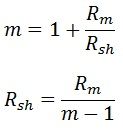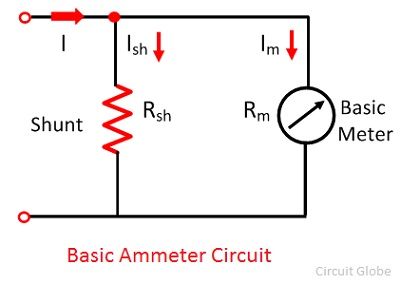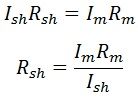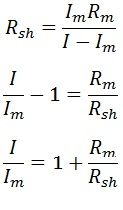Definition: The ammeter shunt is the device which provides the low resistance path to the flow of current. It connects in parallel with the ammeter. In some of the ammeter, the shunt is inbuilt inside the instrument while in others it is externally connected to the circuit.
Why Shunt Connect in parallel with Ammeter?
The ammeter designs for measuring the low current. For measuring the heavy current, the shunt is connected in parallel to the ammeter. The significant portion of the measurand current passes to the shunt because of the low resistance path and few amount of current passes through the ammeter.
The shunt connects in parallel to the ammeter because of which the voltage drops across the meter and shunt remain the same. Thus, the movement of the pointer is not affected by the shunt.
Shunt Resistance Calculation
Consider the circuit used for measuring the current I. The circuit has ammeter and shunt which is connected parallel to each other. The ammeter designs for measuring the small current say, Im. The magnitude of the current I passes through the meter is very high, and it will burn the meter. For measuring the current I the shunt is required in the circuit. The following expression calculates the value of the shunt resistance.
As the shunt connects in parallel with the ammeter, thus the same voltage drop occurs between them.
Therefore the equation of shunt resistance is given as,
The ratio of the total current to the current requires the movement of the ammeter coil is called the multiplying power of the shunt.
The multiplying power is given as,  The resistance of shunt becomes,
The resistance of shunt becomes, 
Construction of Shunt
The following are the requirements of the shunt.
- The resistance of the shunt remains constant with time.
- The temperature of the material remains same even though substantial current flows through the circuit.
- The temperature coefficient of the instrument and the shunt remains low and same. The temperature coefficient shows the relation between the variation in the physical properties of the apparatus concerning the change in the temperature.
Magainin and Constantan use for making the shunt in the DC and AC instruments respectively.




Hello sir i have a broblem:i am working on electrical system 28 VDC .one alternator of HERTEZELL 70 AMPS 1.96 KW to charge the battery nickle cadmium 24 VDC I am using two shunt one in parallel with battery to measer the current draw by the battery and second one in parallel with ALTERNATOR charging circut .when we increase the rpm of alternator than alternator shows 74 AMPS on digital screen why even battery is fully charge
Sir i have a damaged ammeter whose shunt resistor damaged so i need to repair for that i need current of galvanometer …so how can i find Ig in circut if maximum current read of ammeter is 3amp…plz sir help how to find galvno current ..